What makes a Mexican duck such an odd one? Researchers hunt for answers in Arizona
WHITEWATER DRAW WILDLIFE AREA — Philip Lavretsky sat behind a camouflaged screen, head down but eyes to the sky as a trio of ducks circled in a possible glide path onto the pond before him.
“Don’t move,” he whispered to the others in his blind as the birds circled again, this time zooming directly overhead, between the trees that shaded and obscured his hideout. But the ducks flew on, out of sight.
He was ready at the trigger had these ducks only folded up their wings and come in for a landing in front of him.
But he was no ordinary duck hunter, and these were no ordinary ducks. Lavretsky is a wildlife geneticist from the University of Texas at El Paso, out to capture Mexican ducks, a species about whose habits and critical habitats surprisingly little is known. He and a few colleagues were spread out across this southern Arizona refuge to learn more so that game managers from here to central Mexico could better protect the waterfowl.
The report that the ducks would hear if they fell for his trap would come not from a shotgun, but from a row of explosive charges stuffed into metal cylinders attached to a bunched-up, 30-by-50-foot net and staked into the dirt on the bank.
Each cylinder was open in the rear, so the blast would propel it forward, flinging the net over ducks on the water. A wire led from each rocket to an ignition button in Lavretsky’s hand.
He blew his duck call as group after group disappeared behind trees, and sometimes the racket drew them back for a second look at two mallard decoys he had set out. Ibises and killdeers waded in the pond, but the ducks wouldn’t stop. Eventually, Lavretsky removed the decoys in case they didn’t look right to his targets.
Science, like ducks, can't be rushed.
Were they mallards or some other kind of duck?
That's especially true with these particular ducks. Chris Klasen, a Ducks Unlimited volunteer helping with the study that afternoon in mid-August, said he learned it when he moved from Indiana to Arizona and started chasing desert waterfowl. There was something different about the mallards here.
At least, he thought these brown ducks in the hills and vales of southeastern Arizona were a subspecies of mallard, North America's most abundant duck. So did the U.S. Fish and Wildlife Service.
The birds had most of a mallard’s look, though only some of the males had the telltale green or, more often, partially green head. They hung out with mallards in fall and winter, when mallards returned here from their northern breeding ponds. And the brown-headed local ducks — even the drakes — counted as hen mallards in a hunter’s daily bag limit.
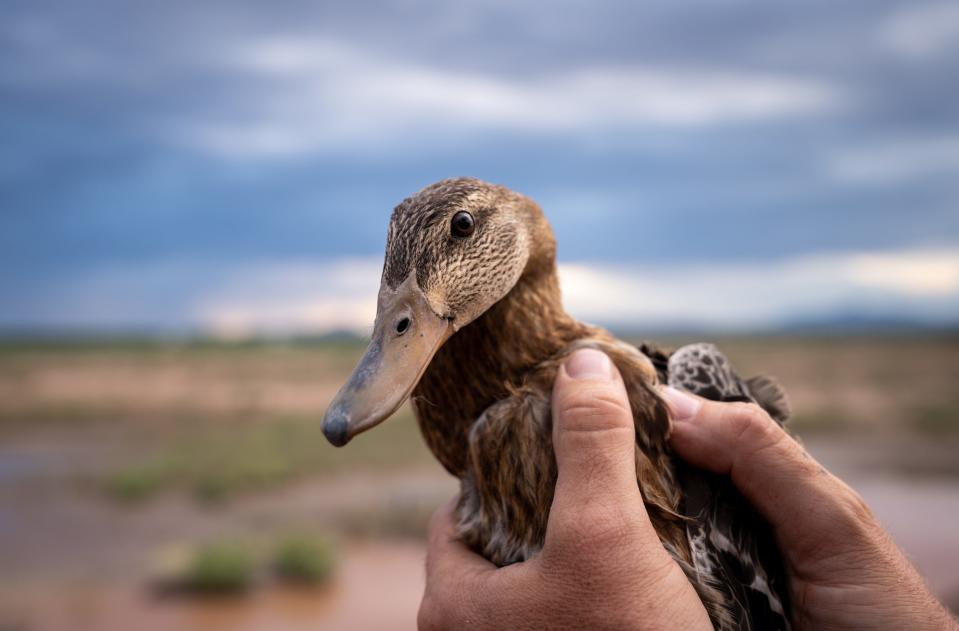
But these ducks were different. There was the head, which even when showing green might only have a streak of it. There was the fact that they stuck around southern Arizona or northern Mexico, not joining the others on seasonal flights north.
And there was something about their behavior, which Klasen described as somewhat gregarious and prone to flocking up when mallards were around, but also skittish, a trait he associates with pintail ducks, making them more difficult to decoy into gun range.
“You get a very wary duck,” he said, “which is the Mexican duck.”
Indeed, it turns out these were and are Mexican ducks, and not mallards after all. But it would take Lavretsky a while to prove it.
Water for the river: To keep the Colorado River's heart beating, people step in to do what nature once did
Mexican ducks had been classified as their own species when then-President Richard Nixon signed the Endangered Species Act, and due to their relative scarcity north of the U.S.-Mexico border, they enjoyed the act’s protection until 1978. That’s when then U.S. Fish and Wildlife Service determined it had erred, and that the Mexican duck was so interbred with mallards that it was, itself, a population of mallards.
Not so, said Lavretsky, who runs his school’s population and evolutionary genetics lab. He collected and sampled the ducks, which generally range through much of central and northern Mexico and the Rio Grande Valley of Texas and New Mexico, and into Arizona. After comparing DNA, he found the Mexican duck to be more different from mallards than mallards are from black ducks, which are classified as their own species.
Lavretsky published a paper with those results in 2015, but said the American Ornithological Union, since rebranded as the American Ornithological Society after a merger, recommended maintaining the bird’s mallard subspecies status until the rate of hybridization could be determined.
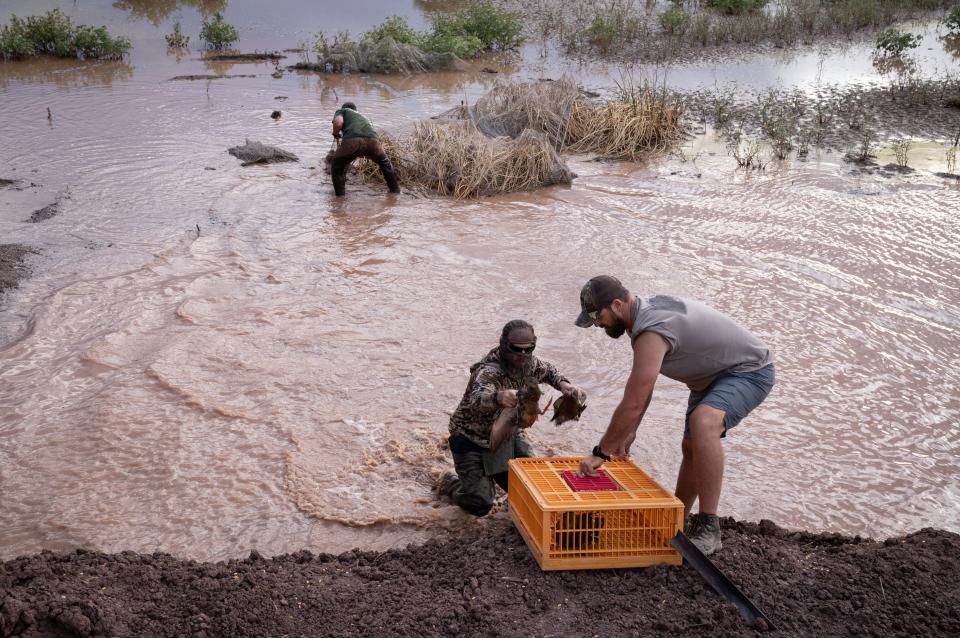
Lavretsky’s further studies in Mexico and the U.S. found that when mallards and Mexican ducks congregate, only 5% are hybrids. That compares to a hybridization rate of 25% between mallards and black ducks, he found. This research led the experts and the Fish and Wildlife Service to again reclassify Mexican ducks four years ago, this time back to their own species.
Glaciation a half-million years ago forced the ancestors of mallards and Mexican ducks into refugia in Arizona and Mexico, according to what Lavretsky called the current hypothesis about their evolution. When the ice retreated to the north, many resumed northern migration patterns, and their line became mallards. But some were content and well-adapted to the desert, and they became Mexican ducks.
Figure out where the ducks go and maybe their population would take off
The same year that Mexican ducks regained their species status, Klasen turned his passion for duck hunting into a part-time job under the name AZ Desert Waterfowl. The Sierra Vista firefighter began guiding clients from around the country on his days off as they sought to fill out their North American list of duck species bagged. The Mexican duck rounded out the list at 42.
“They’re trophy hunting,” Klasen said. He aids them through his arrangement with a ranch owner for access to hunting grounds on the border. The birds can be unpredictable, given the unpredictable nature of water in the desert, he said. Sometimes a big rainy season leads to hundreds of birds coming within range in Cochise County. Other times, drought disperses them, perhaps to Mexico, to ranchers’ stock ponds, or to hidden wetlands.
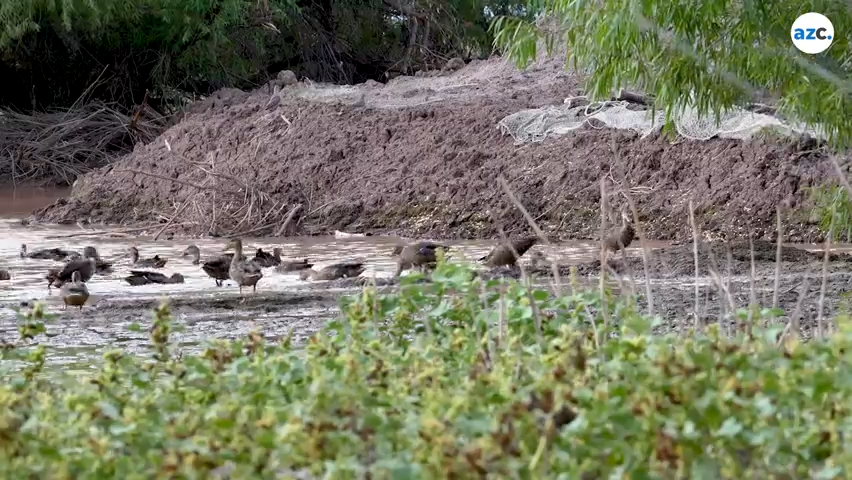
It’s hard to know where they go — or even where they breed — because decades of confusion over their status led to a lack of research.
“We don’t have a lot of water or wetlands,” Klasen said, “but if we could figure out where these birds are going or what they’re using, maybe we could take better care of it and these birds (population) would take off.”
That, now, is what Lavretsky and colleagues at the Fish and Wildlife Service and New Mexico State University aim to learn, with funding support from Ducks Unlimited. So Klasen, a Ducks Unlimited member and volunteer, joined Lavretsky and crew at Whitewater Draw in mid-August to help trap Mexican ducks for the study.
At Whitewater Draw: Tens of thousands of sandhill cranes return to southern Arizona for the winter
The wildlife area, managed by the Arizona Game & Fish Department, is 18 miles northwest of the border town of Douglas, as the duck flies, and 14 northeast of Bisbee. It includes ponds supplied by pumped groundwater. It’s surrounded by a dry valley, scrub, tallgrass, croplands and dirt. Various waterfowl use its ponds and marshes in season, as do sandhill cranes, but the Mexican ducks may be present at any time of year.
By day, the birds fan out in search of food, sometimes plundering nearby cornfields that supply cattle feed to Willcox-area dairies. In the evening, they often return to Whitewater Draw, as they gradually did on the afternoon of Aug. 16, when Lavretsky sat on a folding stool, camouflaged by the limbs of a tree above him and some drab mesh staked in the ground before him.
Waiting, waiting, waiting and then duck! Those are ducks in the net
Dan Collins, the U.S. Fish and Wildlife Service’s migratory bird coordinator who is working with Lavretsky on this study, lay in another blind at a different pond. The two texted back and forth about what they were seeing, each noting when they had a chance to unfurl the nets they minded, but each also holding back in hopes of nabbing more than one or two ducks.
The goal for the day was to fit 10 ducks with aluminum leg bands, and several of either sex with little strap-on backpacks containing radio transmitters to track where they would go in the year after their release.
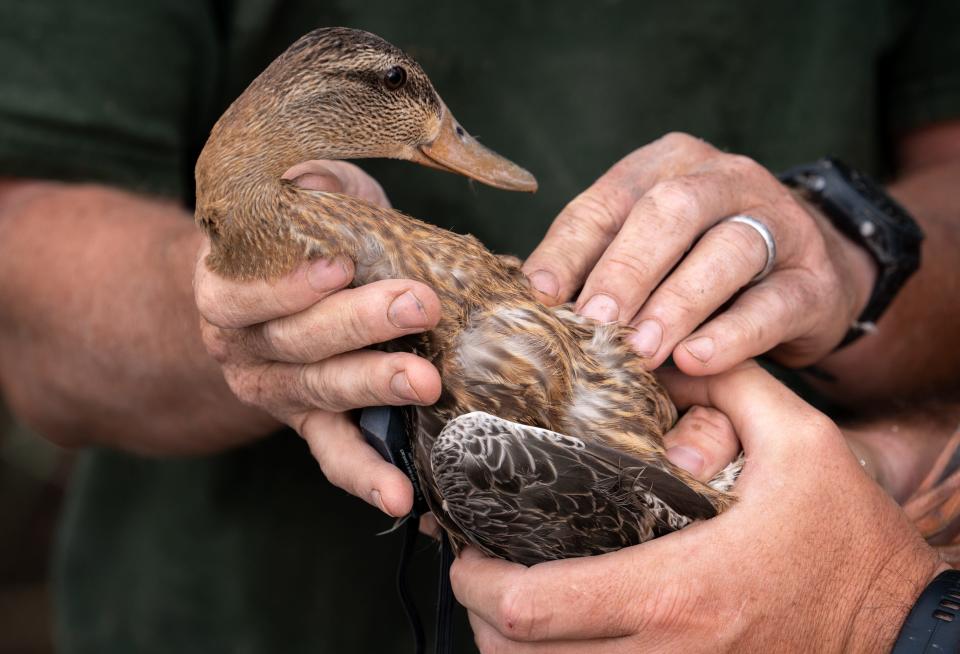
They had anchored one end of each net along the shoreline with rebar and attached the other end to several rockets. Each man held a wired remote to set off the charges, which would fling the net over swimming ducks and hold them until they could grab them and place them in crates.
Lavretsky waited in his blind until, at about a quarter after 4, a lone female Mexican duck finally descended and began gorging on the corn in front of the net. Then a second one joined her.
Lavretsky waited for more and, after 45 minutes, was rewarded with wave after wave of Mexican ducks, dozens in all. Perhaps 20 of them parked themselves in the net’s path before the biologist touched off the rockets to ensnare 11 of them and, momentarily, one of the ibises. The net’s anchor had ripped free from the dirt on one end, flinging the net aimlessly beyond the ducks, or he would have caught more.
Moments after the blast, Collins, Klasen and another volunteer sped up a dike in two trucks, arriving at the pond in time to help gather the ducks and free the ibis before they might drown. After crating the ducks, the crew went to work processing them: a numbered band around the ankle, a solar-powered transmitter on the back with straps over the shoulders and around the chest, blood drawn and measurements taken.
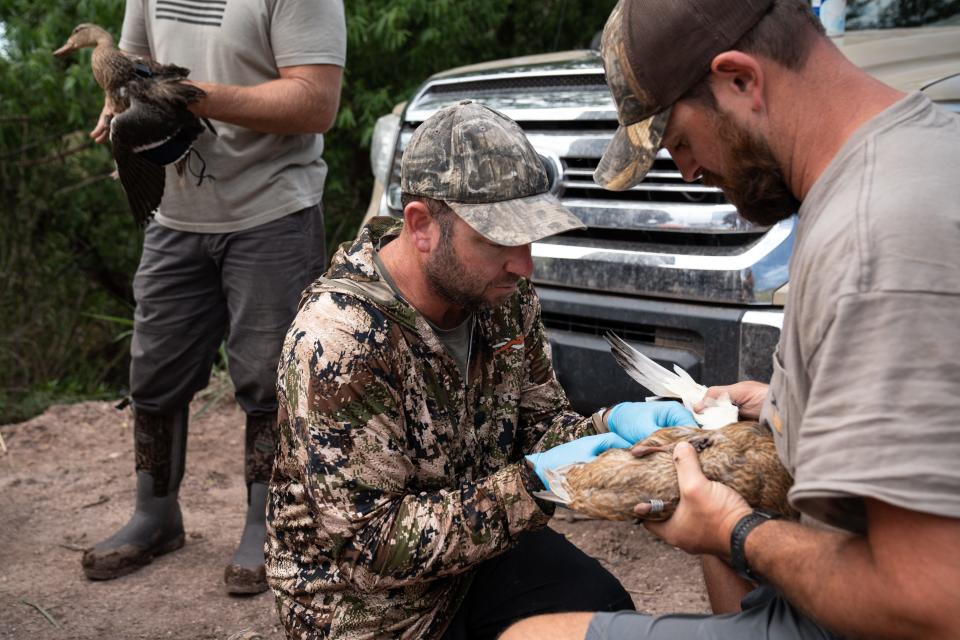
How have the ducks adapted to their desert habitat?
It was a rewarding end to what had been a long day for a crew that arrived on site early enough to see the Perseids meteor shower but failed to lure a duck into their grasp during the morning session. The final count was nine drakes and two hens. They placed transmitters on five of them. With one attached to a hen during in a previous tracking session, that gave them three of each sex to track remotely in the wild.
Ducks Unlimited gave $50,000 to the cause. The U.S. Fish and Wildlife Service added $42,000. Collins said he was able to convince his agency to pay for GPS tracking of the ducks after they were reclassified. New Mexico State is covering costs for a graduate student to assist.
One important aspect of this study is to find out where these ducks breed. As much time as these biologists spend with them in the field, they said, they almost never see them rearing a clutch of ducklings on a nest.
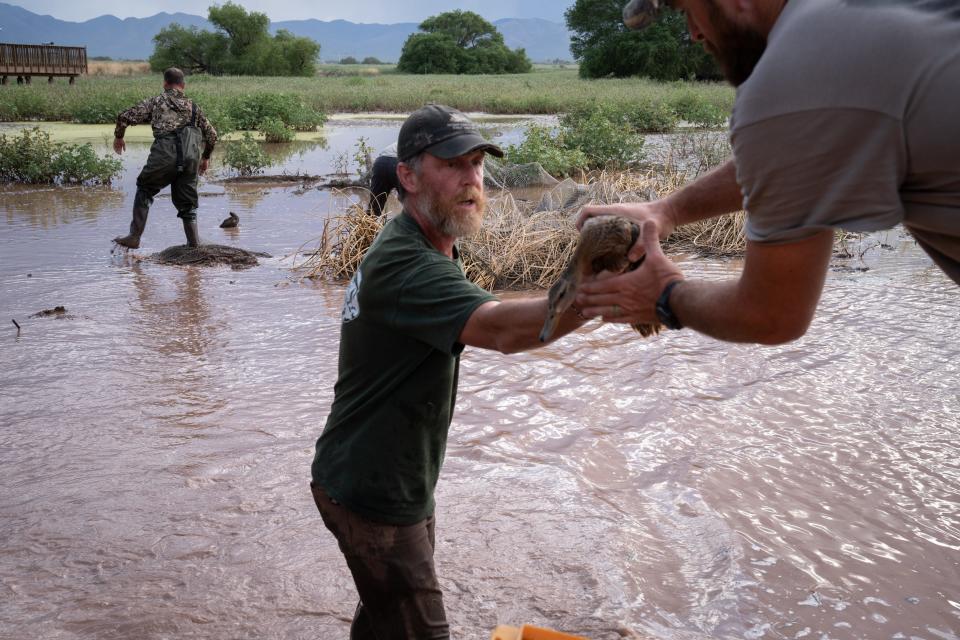
Klasen said a rancher he knows has reported seeing ducklings on next in hillside wetlands, a possible desert adaptation that Collins said could make sense if the ducks are trying to avoid raccoons, foxes, skunks or other predators that frequent the valleys.
It wouldn’t be the only distinction from their cousins, the mallards. Mallards molt a whole new suit of feathers at once, while Mexican ducks appear to molt piecemeal. It can give them a more ragged look, but it also allows them to fly if needed, whereas molting mallards might be flightless for weeks.
Mallards can usually afford the time, the biologists said, because if their pond dries up they can waddle to the next one nearby. In the desert, walking miles to the next suitable nesting site would make them actual sitting ducks for predators.
It's possible Mexican ducks also might be able to breed at any time of year, a hypothesis Lavretsky said he's testing. If so, it’s another adaptation to the desert, allowing the duck to capitalize whenever suitable water and food are available.
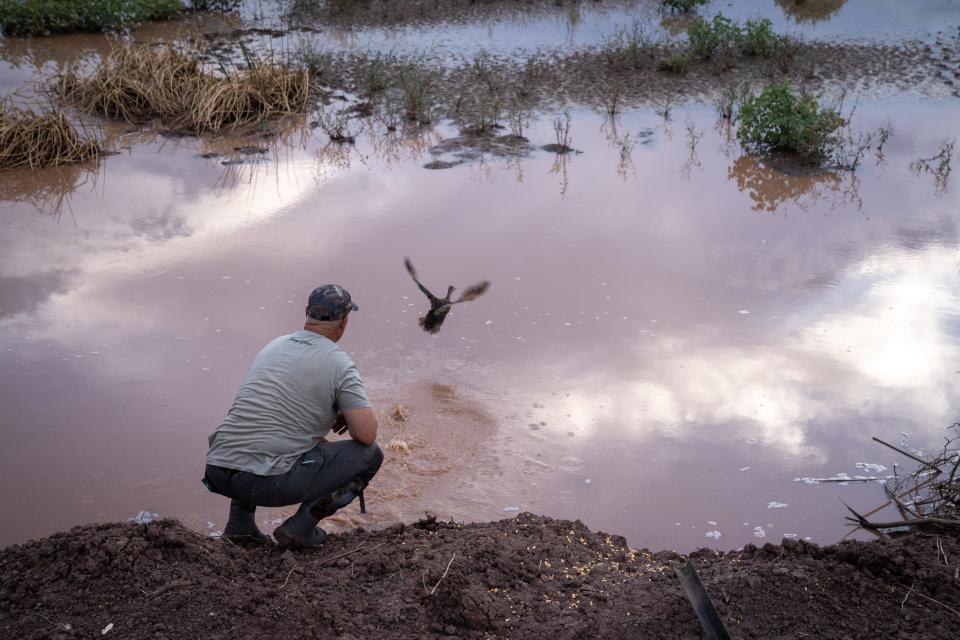
Contrary to their listing during the early days of the Endangered Species Act, Lavretsky said, Mexican ducks appear to be doing well. The most recent survey, now more than a decade old, estimated there are 50,000. But Lavretsky has seen tens of thousands assembled on just one lake in Mexico’s Chihuahua state, and believes there are more.
Models suggest that climate change may help Mexican ducks in their northern ranges, Lavretsky said. While they typically live south of Interstate 40 in Arizona and New Mexico, he knows some are also breeding as far north as Colorado. That’s where biologists banded one, assuming it was a mallard before Lavretsky shot it in Mexico and showed that it was in fact a Mexican duck.
“You can also use these birds as indicators for what’s going on on the land,” he said. If climate change and drought force them to seek new waters, tracking them will show it.
Southern Arizona: Will this hidden gem become a tourist attraction? How park status could affect Chiricahuas
In essence, these scientists are hoping to do for Mexican ducks what others did for Prairie Pothole species decades ago: They want to establish where they live and breed, so conservation efforts might be targeted in the right places. Hence the transmitter backpacks.
“We need some hens to show us the way,” Lavretsky said.
Ducks Unlimited Arizona State Chairman Kevin O’Connell came out for the morning’s capture attempt, eager to learn more about the habits and habitats of one of the state’s unique birds.
“We’ve always believed it was its own species,” O’Connell said. Now that it officially is just that, he hopes this science project in coming years will aid in its conservation.
If it walks like a Mexican duck ...
Q: How can you tell a Mexican duck from a mallard?
A: It's complicated, and for most people might require closer inspection. A field identification primer from the American Birding Association suggests looking at the head. At the male Mexican duck's dark "eye-line," a line pointing to the corner of the eye will stand out. The Mexican duck is darker overall, "with a sharp demarcation between the breast and lighter, more tan-colored throat."
There are also differences in the pattern of breast mottling and in bill colors. Male Mexican ducks, at least in the northern parts of their range, occasionally sport green patches or stripes on their heads, said Lavretsky, the UTEP wildlife geneticist who studies Mexican ducks. That only happens in juveniles and old ducks, but it can fool some observers into thinking they're looking at a mallard hybrid. Lavretsky is collaborating on an app that could make identification easier, even allowing users to snap a picture and get an answer. Meantime, it's probably a good thing that hunters can still count any Mexican duck as a mallard hen in their bag limits, because that's what many people will mistake them for.
Q: Where do they live?
A: Mexican ducks generally range from central Mexico north into Chihuahua and west to the Sinaloa and Sonora coasts, and into west Texas, southern and central Arizona and in the Rio Grande Valley of New Mexico. In Arizona, they're mostly south of I-40, and especially in Cochise County. But they're known to breed at least as far north as Colorado, and biologists say they may be poised to expand their range northward as the climate changes.
Q: Are they endangered?
A: No, though federal biologists thought so back in the early 1970s before they were temporarily reclassified as a mallard subspecies. Not much information has been gained about their habitat needs since then, but they are known to number at least in the tens of thousands and may be growing in number.
"Everywhere I go where Mexican ducks are, there's an abundance," Lavretsky said. Maybe the clearest sign that they're not endangered: You can still shoot a couple of them a day during duck season if you like.
Brandon Loomis covers environmental and climate issues for The Arizona Republic and azcentral.com. Reach him at brandon.loomis@arizonarepublic.com or follow him on X @brandonloomis.
Environmental coverage on azcentral.com and in The Arizona Republic is supported by a grant from the Nina Mason Pulliam Charitable Trust. Sign up for AZ Climate, our environment newsletter and follow The Republic's environmental reporting team at environment.azcentral.com and @azcenvironment on Facebook, X and Instagram.
You can support environmental journalism in Arizona by subscribing to azcentral.com today.
This article originally appeared on Arizona Republic: Mexican duck study to yield clues for Arizona waterfowl conservation

